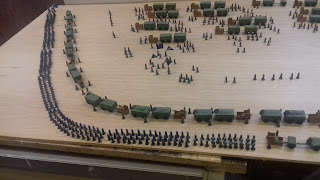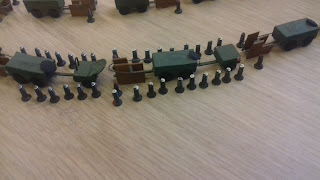For those who read my IMAGI-NATIONS posts, this Battle Photo Shoot illustrates the advance of UNION forces in pursuit of the French during late June 1875. (See IMAGI-NATIONS Part 25.) Once again my apologies for the lack of suitable background. This scene is set on a board 4 feet by two feet which may give some perspective for the size of the units shown.
The scene depicted in the photographs shows the UNION 161st Infantry battalion advancing north. Moving in the opposite direction is a QM transport company of the 22nd Quartermaster battalion returning to railhead to reload with supplies preceded by an ambulance company of the 17th Medical battalion taking wounded to the field hospital just around the next bend in the road. Pulled over to clear the road is the 17th Infantry Brigade Command battalion.
In the above the Infantry battalion can be seen moving towards the camera with the Transport and Ambulance companies moving away. The command battalion is drawn up in the area to the centre of the board.
Above can be seen the command group of the Infantry battalion.
The infantry companies alongside the transport company.
The heavy weapons and transport wagons of the Infantry beside the Ambulance company.
A close up of the infantry and GS wagons of the transport company.
Above is a close up of the infantry battalions wagon lines showing the medical platoon and signals platoon.
A view of the heavy weapons company following the infantry with GS supply wagons in the background..
The infantry heavy weapons.
A shot of the ambulance company which precedes the transport company.
The Command battalion. Note the perimeter is guarded by a line of field police.
The house bodied office wagons for the staff. If you expand the photo you will see the tactical sign of a red square on the rear of each Command wagon.
The signals wagons.
The Command battalion support and supply wagons.
The actual command group reviewing the passing infantry battalion. The national and battalion flags can be seen together with the Generals flags. The battalion has a Major General in command with two Brigadier Generals as deputies. Each General has a flag with stars denoting his rank, eg. one or two stars.
A close up of the Field Police perimeter guard.
Another view of the whole Command battalion.
Another view of the Command group reviewing the passing Infantry battalion.
Finally another view of most of the board showing the Field Police security perimeter.
I hope this shoot is of interest. It took a long time to set up and put away but I had a lot of fun seeing over two battalions set up in a battle field scenario rather than just on shelves.
Just for information, the total number of soldiers seen on the board is 640. To put this in perspective I have over 50,000 soldiers organised in 213 battalions all together.. The infantry battalion alone, marching n columns of three occupies almost six feet of road. Please do let me have comments especially any ideas for future battle photo shoots.




















